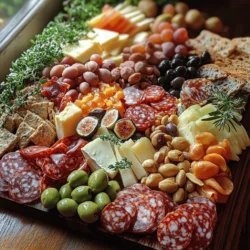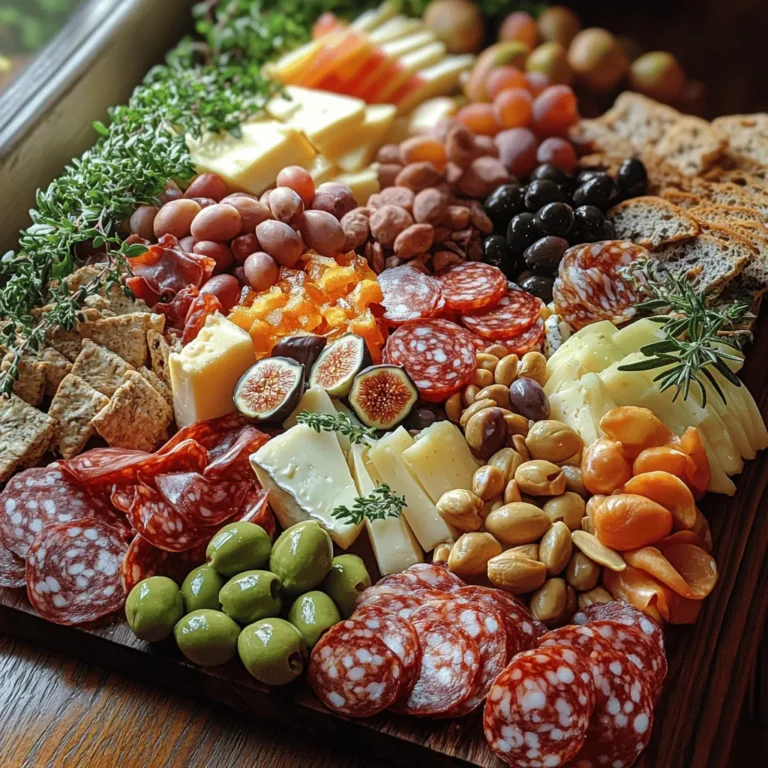Savory Snack Symphony: Easy Charcuterie Board
In the realm of culinary delights, few things are as inviting and visually appealing as a charcuterie board. This artful assembly of cured meats, cheeses, fruits, and accompaniments has surged in popularity as a delightful social food option, particularly during gatherings and celebrations. From casual get-togethers to elegant soirées, a well-constructed charcuterie board serves as a centerpiece that encourages guests to mingle and savor a variety of flavors. This article aims to guide you through the process of creating your own stunning charcuterie board, breaking it down into manageable steps while emphasizing the creativity and artistry involved in its assembly.
Understanding the Charcuterie Board
Charcuterie, derived from the French word for “cooked meat,” traditionally refers to the preparation and preservation of meats, particularly those that are cured, smoked, or salted. The concept of a charcuterie board has evolved significantly over the years, expanding beyond merely showcasing meats to include an array of cheeses, fruits, nuts, and other delightful accompaniments. Historically, charcuterie boards were a practical solution for preserving food and utilizing leftovers, but today, they have become a celebrated form of culinary art.
There are several types of charcuterie boards to consider, each offering a unique twist on this classic idea. Traditional boards typically feature a selection of cured meats and cheeses, while modern interpretations might integrate elements like artisanal breads, homemade dips, or even themed decorations to match the occasion. Themed boards can range from seasonal selections highlighting autumn harvests to vibrant summer fruits, making them adaptable for any gathering. The versatility of charcuterie boards is part of their allure, allowing for endless creativity and personalization.
Selecting the Right Ingredients
Creating a balanced and visually appealing charcuterie board begins with selecting the right ingredients. The key to a successful board lies in offering a diverse range of flavors and textures that will engage the palate and inspire conversation. Here’s a closer look at the essential components that will elevate your charcuterie experience:
Cured Meats
Cured meats serve as the foundation of any charcuterie board. The variety available today is astounding, with options ranging from classic salami to delicate prosciutto and robust chorizo. Each type brings its own unique flavor profile:
– Salami: Known for its rich, spicy notes, salami pairs well with milder cheeses and can be sliced thinly for easy snacking.
– Prosciutto: This Italian delicacy offers a delicate, slightly sweet flavor that complements fresh fruits and nutty cheeses beautifully.
– Chorizo: With its smoky, spicy kick, chorizo adds an exciting contrast to the mildness of other ingredients.
When selecting cured meats, strive for a balance of flavors and textures. Consider including at least three types to create a diverse tasting experience.
Cheeses
No charcuterie board is complete without a selection of cheeses, which can range from soft to hard and mild to strong. A well-rounded cheese assortment can include:
– Brie: This creamy, soft cheese provides a rich counterpart to savory meats and pairs well with fruits like figs or apples.
– Cheddar: A classic choice, cheddar offers a sharpness that balances the richness of cured meats and is versatile enough to suit various palates.
– Gouda: With its nutty flavor, gouda adds complexity and pairs wonderfully with both sweet and savory accompaniments.
– Blue Cheese: For those who appreciate bold flavors, blue cheese introduces a pungent, tangy element that can be offset by sweet fruits or honey.
When assembling your cheese selection, aim for a variety of textures and flavors to complement the meats and other ingredients.
Fresh Fruits
Incorporating fresh fruits into your charcuterie board not only adds pops of color but also introduces sweetness and freshness to counterbalance the richness of meats and cheeses. Consider using:
– Grapes: Easy to pick and eat, grapes offer a burst of sweetness that pairs beautifully with both cheese and cured meats.
– Apples: Crisp and refreshing, apple slices can provide a delightful crunch and contrast to creamy cheeses.
– Figs: Whether fresh or dried, figs can lend a luxurious sweetness that works harmoniously with savory flavors.
Mixed Olives
Olives are another essential element that enhances the flavor profile of your charcuterie board. Their briny, savory taste can complement meats and cheeses alike. Explore different types of olives, such as:
– Kalamata: These dark purple olives have a robust, fruity flavor that pairs well with Mediterranean-style boards.
– Green Olives: Briny and tangy, green olives add a zesty kick and can serve as a perfect palate cleanser between bites.
Mixed Nuts
Adding a variety of nuts to your charcuterie board can introduce a satisfying crunch and additional flavor. Nuts like almonds, walnuts, and cashews are excellent choices. They not only enhance the board’s visual appeal but also offer a nutritious snacking option. Consider lightly salting or toasting your nuts to elevate their flavor.
Breads and Crackers
A charcuterie board wouldn’t be complete without a selection of breads and crackers, which serve as the perfect vessel for enjoying meats and cheeses. Including a variety of options can enhance the experience:
– Baguette Slices: Crispy on the outside and soft on the inside, baguette slices are ideal for topping with cheese or spreads.
– Crackers: Opt for a mix of textures, from plain water crackers to more flavorful options like rosemary or garlic.
– Breadsticks: These crunchy snacks can be used to scoop up dips or simply enjoyed on their own.
Choosing Your Presentation Board
Once you’ve selected your ingredients, the next step in creating your charcuterie masterpiece is choosing the right board or platter for presentation. The visual appeal of a charcuterie board is crucial, as it draws guests in and sets the tone for the gathering. Here are some recommendations for selecting the ideal presentation surface:
– Wooden Boards: A rustic wooden board can enhance the natural beauty of your ingredients and provide a warm, inviting backdrop.
– Marble Slabs: For a more elegant touch, consider using a marble slab, which not only looks sophisticated but also helps keep cheeses cool.
– Slate Plates: Slate offers a unique, modern aesthetic and can be easily labeled with chalk, making it easy for guests to identify different ingredients.
Ultimately, the choice of presentation board should reflect your personal style and the theme of your gathering.
{{image_2}}
Crafting the perfect charcuterie board is more than just arranging meats and cheeses; it’s an artistic expression that combines flavors, textures, and colors to create an inviting centerpiece for any gathering. In this section, we will guide you through the assembly of your charcuterie board, offer tips for presentation, and suggest ways to enhance your guests’ experience. Let’s dive in!
Size Considerations for Your Charcuterie Board
When planning your charcuterie board, size is an essential factor to consider. It should accommodate the number of servings you need while leaving enough space for artistic arrangement. Here’s how to gauge the right size:
– Guest Count: A good rule of thumb is to allocate about 3-5 ounces of meat and cheese per person. For example, if you’re hosting a gathering of 10 people, aim for 30 to 50 ounces of food. Adjust the quantities based on your guests’ appetites and the overall menu.
– Board Size: Choose a board that can comfortably hold all your selections without looking overcrowded. A large wooden or marble board works well, but even a decorative tray can serve if space is limited. Ensure that there’s enough room for each component without cramming, which can detract from the overall appeal.
– Visual Balance: Consider the proportions of your ingredients. A board that is too crowded may look chaotic, while one with too much empty space can appear sparse. Strive for balance in both quantity and placement.
Decorative Serving Pieces and Their Impact
The presentation of your charcuterie board can elevate the entire experience, making it not just a meal, but a visual feast. Consider these decorative elements:
– Serving Utensils: Incorporate small cheese knives, forks, and serving spoons that match your theme. This not only makes it easier for guests to serve themselves but also enhances the aesthetic appeal.
– Dishes and Bowls: Use small bowls to hold dips, olives, or nuts. Opt for colors that complement your main board, such as rustic ceramics or elegant glassware.
– Textured Linens: A patterned or textured tablecloth or runner can add depth. Choose colors that contrast nicely with your board for a more striking appearance.
– Natural Elements: Incorporate fresh herbs or edible flowers around the board. They add a pop of color and a hint of freshness that invites curiosity.
Step-by-Step Assembly of Your Charcuterie Board
Now that you have a clear vision of your board’s size and presentation, let’s move to the assembly process. Follow these detailed instructions to create a visually stunning and delicious charcuterie board:
1. Creating Sections for Cheeses
Start by selecting your cheeses. Choose a variety of textures and flavors, such as a creamy brie, a sharp cheddar, a tangy goat cheese, and a blue cheese.
– Placement: Arrange the cheeses in different sections of the board. You can slice some cheeses into wedges and leave others whole for visual contrast.
– Artistic Presentation: Use a variety of shapes—cubes, slices, and wedges—to add interest. Consider using a cheese knife to create decorative slices on the brie or to crumble the goat cheese.
2. Layering and Arranging Meats
Select a mix of cured meats, such as prosciutto, salami, and chorizo.
– Visual Interest: Roll or fold the slices of meat instead of laying them flat. This technique creates height and dimension on your board. You can also create small fan shapes or rosettes for a more artistic presentation.
– Strategic Placement: Position the meats near the cheeses that pair well with them, enhancing the flavor experience for your guests.
3. Strategically Placing Fruits
Fruits add a splash of color and a hint of sweetness to balance the savory elements.
– Fruit Clusters: Use vibrant options, such as grapes, apple slices, or dried fruits like apricots and figs. Arrange them in small clusters to create visual focal points.
– Contrast: Consider using both fresh and dried fruits to provide different flavors and textures, enhancing the overall appeal of the board.
4. Incorporating Olives and Nuts
Fill in the gaps on your board with olives and nuts, which add crunch and flavor contrasts.
– Placement: Use small bowls for olives or nuts to keep them contained and organized, or scatter them directly on the board for a more casual feel.
– Variety: Offer a selection of nuts—consider almonds, walnuts, or pistachios—and a mix of olives, such as kalamata and green olives, to appeal to different palates.
5. Arranging Breads and Crackers
Choose a variety of bread and crackers that will serve as the perfect vehicle for your meats and cheeses.
– Accessibility: Arrange breads and crackers in a way that’s easy for guests to pick up. Consider placing them in a fan shape or in small stacks.
– Texture and Flavor: Include a range of options—from crusty baguette slices to crispy water crackers—to cater to diverse tastes and preferences.
6. Final Touches
Once all your ingredients are placed, it’s time for the finishing touches.
– Condiments: Drizzle honey or fig jam in small bowls or directly onto the board. These sweet elements can complement the cheeses and meats beautifully.
– Garnish: Add fresh herbs like rosemary or thyme around the edges for a fragrant and visually appealing finish. They add a touch of freshness and invite guests to explore.
The Art of Presentation
The presentation of your charcuterie board is key to making a lasting impression. Here are some tips to enhance its overall look:
Engaging Your Guests with Labels
Consider adding labels to identify the different cheeses and meats. This not only informs your guests but also sparks conversation.
– Creative Labels: Use small chalkboard signs or handwritten tags to name each item. This adds a personal touch and encourages guests to try new flavors.
Beverage Pairing Suggestions
Pairing your charcuterie board with the right beverages can elevate the experience.
– Sparkling Water: Offer sparkling water with lemon or lime slices for a refreshing non-alcoholic option. Its effervescence complements the richness of the cheese and meats.
– Wine Pairings: For those who enjoy wine, suggest red wines for bold flavors and white wines for lighter cheeses. Consider a rosé for a versatile option that pairs well with a variety of meats and cheeses.
Serving Suggestions and Enjoyment
When it’s time to serve your charcuterie board, keep these etiquette tips in mind:
– Encouraging Guests: Invite your guests to help themselves, and encourage them to mix and match flavors. This interactive element fosters conversation and enhances the experience.
– Social Aspect: A charcuterie board is best enjoyed in a communal setting. Position it at the center of your gathering space to promote sharing and interaction among guests.
Conclusion
Assembling a charcuterie board is a delightful blend of creativity and culinary exploration. It allows you to express your personal taste while providing an inviting centerpiece for social gatherings. The joy of selecting flavors, arranging ingredients, and engaging guests in conversation makes the process as rewarding as the final product.
Encourage yourself to experiment with different flavor combinations, textures, and presentations. Each charcuterie board can tell a unique story, reflecting your tastes and the essence of the occasion. Remember, sharing food is not just about nourishment; it’s about creating memories and fostering connections. So gather your ingredients, unleash your creativity, and enjoy the experience of sharing your savory snack symphony with friends and family.


